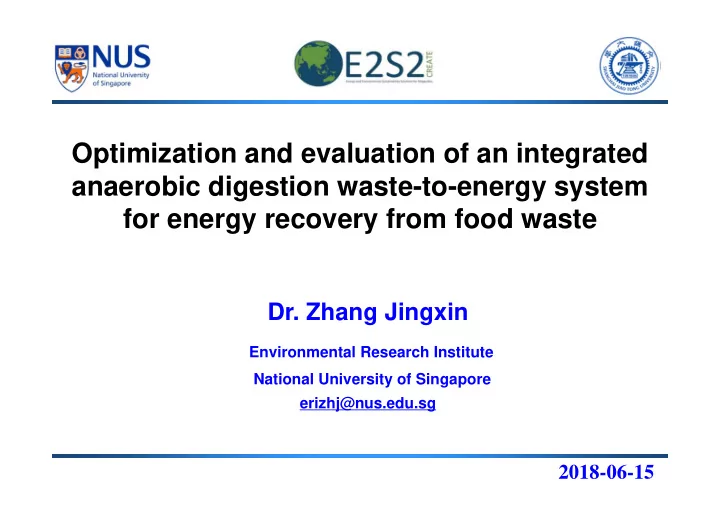

Optimization and evaluation of an integrated anaerobic digestion waste-to-energy system for energy recovery from food waste Dr. Zhang Jingxin Environmental Research Institute National University of Singapore erizhj@nus.edu.sg 2018-06-15
Presentation Structure 1. Background 2. Anaerobic Digestion Technologies 3. Waste-To-Energy systems 1
1. Background Energy and Environment Environmental Concerns 3 Energy Crisis Fossil fuel: Non-renewable Nuclear energy: High risk Renewable energy : Biomass energy National Demand: Environmental pollution control and Sustainable energy resource - “Waste-To-Energy” 2
□ Waste management in Singapore Waste Generated 7.7 million tons/year Singapore Waste Recycled Collection & Sorting million tons/year (61%) Electricity Non-incinerable waste & Hot Steam 0.15 million tons/year (2%) Ash 0.28 million tons/year Singapore’s only Landfill Incineration Plants Semakau Landfill 3
□ Anaerobic Digestion Waste-to-Energy system Dry wastes Collection & Sorting Incineration & Gasification Agricultural Food Waste Anamial Horticultural Wastewater Waste Manure Waste Building Electricity Anaerobic digestion Cooling Fertilizer Anaerobic Digestion Digestate Waste Heat Chiller Engine Generator Recovery 4
□ Challenges and Demands Chellenges Demands High sorting efficiency Waste sorting High treatment capacity Sensitive Low energy consumption Energy Intensive Efficient energy recovery Low energy recovery 5
□ Objectives and contributions Objectives : To develop a novel method or apparatus for high efficient anaerobic digestion of organic wastes. To design and fabricate a sustainable and efficient waste-to- energy system for electricity generation and heat recovery Contributions : Waste Reduction, Environmental Pollution Control, Zero Waste Net energy (electricity and heat) or resource (fertilizer) output 6
7 2. Anaerobic Digestion Technologies Anaerobic digestion (AD) – Technology level Anaerobic digestion
□ Bioreactor design 1. Zero Valent Iron (ZVI) – Anaerobic digester ZVI is a reductive material that can serve as electron donor for methanogenesis (8H + + 4 Fe 0 + CO 2 = 4Fe 2+ + CH 4 +2H 2 O). ZVI accelerate granulation High abundance of methanogens Higher Methane Yield; ZVI bed Buffering Organic acids; Neutral pH; Stable operation ; Higher treatment capacity. ZVI – Anaerobic Digester H 2 utilizing methanogens 8
□ Biological enhancement additives Activated carbon and biochar “Activated car bon der ived fr om char fr om biomass gasification and its application fordye r emoval and wastewatertr eatment” Property ‐ High porosity Ac tivatio n ‐ Large surface area ‐ Strong absorption B iochar Activated Car bon Activated carbon improved 230% CH 4 yield 10
Metabolic mechanisms Potential Direct interspecies electron transfer for syntrophic metabolism Metagenomic analysis Metabolic pathway of Lipids Dominant metabolic pathways: Lipid, Propanoate and Energy Metabolism 11
(3) Waste-To-Energy systems Anaerobic digestion Energy System (Technology level) (System level) 12
□ Food Waste-To-Energy system Combined Heat and Power System Biogas Food Waste Recovery Electricity and heat Anaerobic Digestion System Net energy output Reduction of energy consumption of the whole AD energy system 13
Reduction of Energy Consumption in the Energy System Model + Experiments Computational Fluid Dynamics Semi-continuous mixing strategy (CFD) modelling for mixing Different Scales of Engine Generator systems 14
□ Demonstration of NUS-SJTU in Singapore 15
Thank you for your attention!
Recommend
More recommend